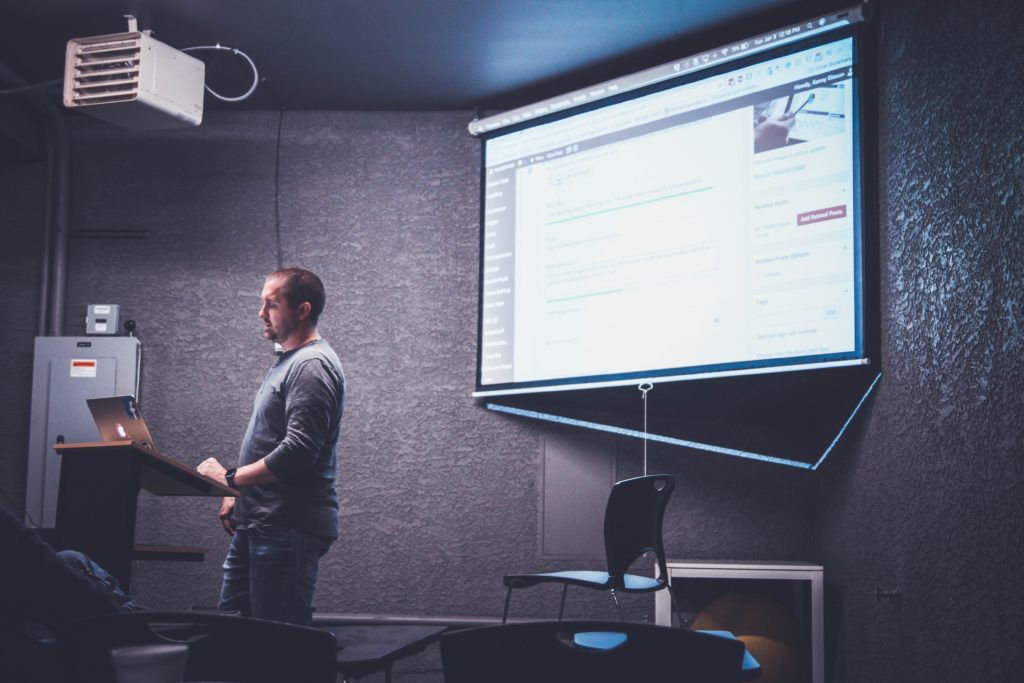I recently had to present a slide deck of new material (not my own) for a major financial institution with very little preparation and limited understanding. It was great! No, I’m not being sarcastic. It was a reminder of the challenges business presenters are faced with every day. And the truth is – I actually thrive on the nerves! I’ve made friends with my nerves, never denying they’re around. I have learned to harness the nerves I feel into energy that I am able to put into the presentation. I have a set of tools that help me when I get nervous that I can share with you.
Awareness:
I know I never look or sound as nervous as I feel. And here’s a gift – you don’t either! No matter what is going on inside, a presentation always feels worse then it appears. Don’t believe me? I have worked with thousands of presenters all over the world doing detailed analysis video playbacks and the one constant is everyone looks better then they think. Try it yourself. Of course there are things to work on but just know that no one knows what’s going on in your head but you. This is something I emphasize in my pitching skills workshop.
Breathe:
When I’m nervous, my breathing gets shallow and I deprive my brain of much needed oxygen so I make a conscious choice to breathe right before I begin. I take two or three deep breaths so I can feel my feet on the ground and steady myself. As I breathe, I take my time. I look for a friendly face I can connect to for my opening sentence. So I’m like a pitcher focusing one thought on an individual, like one pitch to a catcher. I think of my presentations as an opportunity to speak to individuals within the group rather then addressing a whole group at once and not making any deep connection with anyone. When I connect, I relax. I get my attention off myself and onto my audience.
Visualize:
I say positive things to myself. I imagine the speech going very well. Sometimes right before I begin, I think of something I am proud of or the last time I presented well. This gives me confidence that this too will go well.
Body Language:
I find a private space like a bathroom and stand with my hands up in victory for 30 seconds. A great deal of scientific research has been done on the effects of body language on your state of mind. Traditionally, body language has been a tool to manage how we would like to be perceived but I would encourage presenters to find a power position as part of their preparation to address how they feel. Amy Cuddy, a body language expert has done some interesting research on this subject and I encourage you to check out her TED Talk.
Troubleshooting:
Always test the equipment. Microphones feed back sound. Some are very sensitive to sound while others are faint. Most microphones these days are multi directional, others you have to lean into to be heard – so double check sound before anyone arrives. Test the sound with the audio visual person if possible. If you’re showing a PowerPoint on a computer, have a flash drive back up just in case. In fact, you should have a plan B for every aspect of your presentation. And believe me, it’s the little things that kill you. Electrical extension cords, proper electrical converter appropriate to the country that you’re in, insufficient lighting at the podium to read your notes, etc… the more prepared, the less nervous you will be. Doing whatever you can to eliminate the unknown, will help you manage nerves.
Practice:
The key to practising a presentation is doing it out loud. The physical act of speaking is different from the process of thinking it through and the unknown sensation of saying the words, phrasing the thoughts, thinking on our feet, hearing your voice can be anxiety provoking. Practice out loud at least 3 times. Preferably with a partner. If you can’t practice the whole presentation out loud, at least do the opening few minutes. It’s when you’re most likely to be nervous and self conscious. If you start on solid footing, it will most likely carry you through the rough patches.
Exercise:
The day of a presentation, do something physical to get your blood flowing, your heart pounding, and out of a head that’s filled with anxious thoughts of failure. Exercise helps us stay present.
Movement:
Commit to your gestures and your movement and do them fully. It will help you channel your nerves into energy. There is a difference between movement that reveals anxiety and movement that is strong and affective. Movement with commitment and purpose will allow you to connect with your body and be more authoritative. And will calm you. As long as you move with purpose. To be clear, habitual shuffling of feet or clasping hands is NOT what I mean by effective movement. I’m also not a fan of having a pen or a laser pointer as they can limit our gestures and our expressiveness. (I know this is controversial, but I have seen my fair share of presenters distract an audience by clutching a pen or laser pointing every detail on a slide to drive us to distraction.)
Water:
Feel free to have some handy in case you experience dry mouth. Remember your allowed to be a human being up there and water helps us pause, and get back into a more calm and confident head space.




